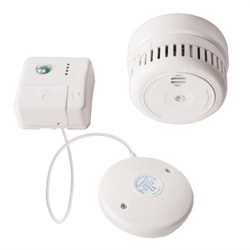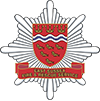How many smoke alarms do you need?
You should have a minimum of one alarm on each floor but the more you have, the safer you'll be.
There are two types of smoke alarm:
Ionisation alarms
- Ionisation alarms are the cheapest and most readily available smoke alarms.
- They are very sensitive to 'flaming fires' - fires that burn fiercely, like chip-pan fires. Ionisation alarms will detect flaming fires before the smoke gets too thick.
Optical alarms
- Are more expensive. However, they are more effective at detecting slow-burning fires, like smouldering foam-filled furniture or overheated wiring.
- Are less likely to go off accidentally and so are best for ground-floor hallways and for homes on one level.
How many?
For the best protection, you should install one of each. However, if you can't have both, it's still safer to have either one, rather than none at all.
Whichever model you choose, you should make sure that it meets British Standard BS EN 14604 and ideally also carries the British Standard Kitemark.
The different smoke alarm models available
A lot of people forget to check their smoke alarms, so the best choice of power supply is usually the one that lasts longest.
Standard-battery alarms
An 'ionisation battery alarm' is the cheapest and most basic smoke alarm available. An 'optical battery alarm' is a little more expensive. Both run off 9-volt batteries.
Battery alarms with an emergency light
These come fitted with an emergency light which comes on when the alarm is triggered. They are particularly suitable if someone in your house has hearing difficulties and may help light up an escape route.
Alarms with ten-year batteries
These are slightly more expensive, but you save on the cost of replacing batteries. They are available as ionisation/optical alarms and are fitted with a long-life lithium battery or a sealed power pack that lasts for ten years.
Mains-powered alarms
These are powered by your home's electricity supply and need to be installed by qualified electricians. There's no battery to check, although they are available with battery back-up in case of a power cut.
Interconnecting or linked alarms
Some alarms can be connected to each other so that when one senses smoke, all the alarms in the property sound. They are useful for people with hearing difficulties and also in larger homes.
Mains-powered alarm with strobe light and vibrating pad
These are designed for people who are deaf or have hearing difficulties. If there's a fire, the alarm alerts you with a flashing light and vibrating pad - which is placed beneath your pillow.
Mains-powered alarm which plugs into a light socket
This type of alarm uses a rechargeable battery that charges up when the light is switched on. It lasts for ten years and can be silenced or tested by the light switch.
Specialist alarms
People who are deaf or hard of hearing need additional ways of making them aware the alarm has been activated, including vibrating pads and flashing strobe lights.
A whole range of alarms has been designed specifically for the hard of hearing, with features ranging from strobe lighting and vibrating alarms to small wearable radio linked pagers.
These specialist alarms can save lives, alerting people to a fire in their home even if they remove their hearing aid at night.
British Standard BS5446-3:2005, which was amended in 2007, specifies smoke alarm kits for deaf and hard of hearing people. Products made to this standard give deaf people assurance of quality smoke alarms designed to meet their needs.
Installing & maintaining your smoke alarms
- One alarm per floor is a minimum standard
- Based on the fire risk of the occupant, alarms should be fitted in rooms which are regularly inhabited
- A heat alarm in the kitchen is recommended
- Where possible alarms should be interlinked
- Alarms should be replaced after ten years or by replace by date
- Change the battery once a year (unless it's a ten-year alarm)
- The best place for your smoke alarms is on the ceiling, near or at the middle of the room or hall
- If you have only one alarm and but more than one floor, put it somewhere you'll be can hear it when you're asleep
- If you have a large electrical appliance like a computer in any of your rooms you should fit smoke alarms there as well.
- Alarms should be at least 30cm (one foot) away from walls and lights.
- Test your alarms once a week, by pressing the test button until the alarm sounds and use your vacuum cleaner to suck out any dust.
- If it is difficult for you to fit your smoke alarm yourself, ask a family member or friend to help you or contact us to see if you are eligible for a Home Safety Visit.
Remember: Regularly testing and maintaining your smoke alarms will improve their life expectancy and effectiveness.
Reducing False alarms in the home
False alarms in residential properties are common but can be significantly reduced by taking simple precautions:
- Regularly maintain smoke alarms – Test smoke alarms regularly and replace batteries as needed. Ensure the alarm is cleaned to prevent dust buildup that can trigger false alarms.
- Install alarms in appropriate locations – Avoid placing smoke alarms too close to kitchens, bathrooms, or heating appliances where steam, cooking fumes, or heat can set them off but ensure you have one on every level of your home.
- Be mindful of aerosols and steam – Spraying deodorants, hairspray, or cooking aerosols near alarms can trigger false alarms. Ensure proper ventilation when cooking or using steam-producing appliances.
- Check for faulty or aging detectors – If an alarm frequently goes off for no reason, it may be faulty or at the end of its lifespan. Replace outdated alarms as recommended by manufacturers. Visit our Home Safety Visit section of the website for more information.
- Educate household members – Ensure that everyone in the home understands how to use and test alarms properly and what actions might trigger false alarms.

Hearing loss and smoke alarms
If you are deaf or hard of hearing the right smoke alarms give protection and valuable time to escape from a fire.
